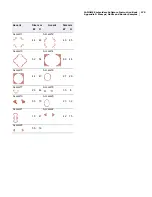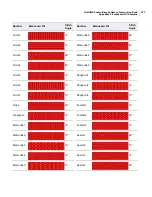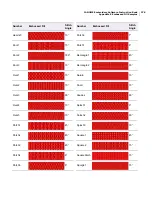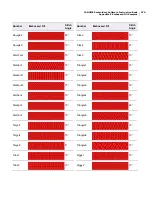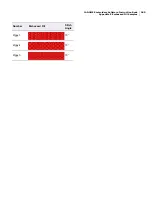
JANOME Embroidery Software Instruction Book
Glossary
289
underlay types. The system can
automatically compensate for the
pull-push effect of different fabrics.
Push, warping, and shearing are
reduced by suitable underlay for
the stitch type and fabric.
Fabric settings: Pre-defined
fabric settings include settings for
all full-coverage stitch types. For
each stitch type, spacing is preset.
Additionally, the quality effects of
pull compensation and underlay
are also preset for each stitch type.
Decorative effects are not affected
when fabric setting are changed.
Fabric stretch: Embroidery
stitches pull the fabric inwards
where the needle penetrates. This
can cause the fabric to pucker, and
gaps to appear in the embroidery.
Use automatic pull compensation
to counter this effect by
‘overstitching’ outlines of filled
shapes.
Facing: See
Topping
.
Factory settings: These are the
initial system settings as installed.
They are a standard known setting
that you can return to. Some
customers want to create custom
settings tailored to the exact fabric
they are using most frequently.
The ‘My Fabric’ settings are those
retained in the design and can be
saved to the template file.
Fancy fills: A digitizing function
that automatically incorporates
special patterns or textures into fill
areas. Also known as ‘specialty
fills’.
Feather Edge: Technique for
creating rough edges, to create
shading effects, or to imitate fur or
other fluffy textures in your design.
File: A named collection of
specifically related information
stored on a disk. Designs that have
been saved are stored as files.
File extension: The dot and
three letters at the end of a
filename such as ‘.BMP’. The
extension identifies the file as a
certain type, readable by certain
applications.
Filename: The name of a file,
including the extension, e.g.
Cat.BMP.
Fill stitch: Series of running
stitches commonly used to cover
large areas. Different fill patterns
can be created by altering the
angle, length and repeat sequence
of the stitches. Also known as
Geflect stitch.
Overlay Removal : This feature
creates filled objects from the
outlines of selected Parallel Fill
objects.
Finishing: Processes done after
embroidery is completed. Includes
trimming loose threads, cutting or
tearing away excess backing,
removing facing or topping,
cleaning any stains, pressing or
steaming to remove wrinkles or
hoop marks and packaging for sale
or shipment.
Fixed Line baseline: A Fixed
Line baseline has a fixed length
which you can digitize or specify
numerically. If the text is longer,
the letter spacing is decreased and
the letters may overlap. The letter
width is not changed. With Fixed
Line, you need to mark two points
to define the base. See also
Baseline
.
Flagging: Up and down motion of
fabric under action of the needle,
so named because of its
resemblance to a waving flag.
Often caused by improper framing
of goods. Flagging may result in
poor registration, unsatisfactory
stitch formation and birdnesting.
Floppy disk: A flexible disk
permanently sealed in a square
plastic jacket – e.g. HD/DD 3.5"
floppy disk. Used for information
storage ‘off-line’ for security and/or
infrequently used data. Also used
for transferring punched
embroidery design (stitch file) data
from computer to embroidery
machine.
Folder: A collection of files and
sub-folders that are stored
together on a disk. Part of structure
for organizing files on a disk.
Font: A set of characters,
including letters, numbers and
other typographic symbols, of the
same design and style. Also called
Alphabet, even if it includes
non-letter characters.
Fringe: Threads that are cut and
hang loosely from the edge of a
design.
Graphics application: Software
application that creates or allows
you to edit bitmap images and/or
vector graphics. See also
Paint
package
and
Drawing package
.
Gradient Fill: An artistic stitch
effect that gradually varies stitch
spacing between dense and open
fill along an embroidery object,
producing shading and color effects
which are difficult to achieve
manually.
Grayscale: A grayscale picture is
made up of 254 different shades of
gray, plus solid black and solid
white for a total of 256 different
tones. Black and white
photographs are grayscale.
Grid: Grid lines provide visual
cues to help you accurately place a
design. When you start the
software for the first time, grid
lines appear by default.
Guide run: Series of stitches
used to align embroideries in
multi-hooping situations or to
assist in fabric placement for
appliqué. It is the first appliqué
layer stitched and is used to
position the appliqué fabric on the
background material. See also
Appliqué
.
Handle: See
Selection Handle
.
Hard disk: A device for mass
information storage. Usually the
disk is fixed inside the system unit,
and a second hard disk can be
added. When you store information
on the hard disk it will remain there
until you delete it. As it has a finite
capacity, file management is
required.
Hardware: Computer
componentry, including monitor,
keyboard, digitizing tablet, printer,
scanner, sewing machine, etc.
Heirloom embroidery:
Embroidered goods designed to be
passed down from generation to
generation.
Hoop: Device made from wood,
plastic or steel used to tightly grip
fabric and stabilizer between an
inner and outer ring. Designed to
hold fabric taut against the
machine bed for embroidering, it
attaches to machine’s frame.
Summary of Contents for DigitizerPro
Page 236: ...234 Part IX Software Feature Table ...

